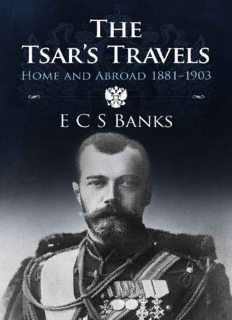
The Tsar's Travels: Home and Abroad 1881-1903 The Romanov PDF
Preview The Tsar's Travels: Home and Abroad 1881-1903 The Romanov
The Tsar’s Travels Copyright Notice Published in 2013 by the author using SilverWood Books Empowered Publishing® 30 Queen Charlotte Street, Bristol BS1 4HJ www.silverwoodbooks.co.uk Copyright © ECS Banks 2013 The right of ECS Banks to be identified as the author of this work has been asserted by ECS Banks in accordance with the Copyright, Designs and Patents Act 1988. All rights reserved. No part of this publication may be reproduced, stored in a retrieval system, or transmitted in any form or by any means, electronic, mechanical, photocopying, recording or otherwise, except for review purposes, without prior permission of the copyright holder. All photos, postcards and images are from the author’s own collection. ISBN 978-1-78132-140-9 (paperback) ISBN 978-1-78132-138-6 (Road to Revolution ebook) ISBN 978-1- 78132139-3 (The Tsar’s Travels ebook) Introduction The third part of my work on the lives of the Grand Duchesses is mainly concerned with their father, Tsar Nicholas II of Russia. The girls all worshipped their father and in their eyes he could do no wrong. His daughter Olga was particularly close to him. To understand the characters of the four Grand Duchesses, it is important to understand their father. Each generation is influenced by the previous generation and that is why my books go backwards rather than forwards, profoundly influenced by Wagner’s Ring Cycle opera. Nicholas was himself influenced profoundly by his late grandfather, Emperor Alexander II of Russia, particularly by his actions shortly before his murder in 1881. Alexander’s bravery in the face of danger was to influence Nicholas for the remainder of his life and explains why he appeared to be unmoved no matter what fate threw at him. Nicholas’s early introduction to assassination was swiftly followed by an attempt on the lives of the entire Imperial family (whether by accident or design, the consequence would have been the same) during the ill fated train journey through Borki in 1888. On a tour of the Far East in 1891, Nicholas narrowly escaped death when an off duty Japanese policeman attempted to kill him with a huge sword. The tour of the Far East came at a time when Nicholas was pining for the beautiful Princess Alix of Hesse and as a result he failed to appreciate the journey as he would have done in normal circumstances. Nicholas spent his early years in the army, where he was at his happiest. The routine of the army suited his submissive character perfectly and even when he became Tsar he preferred to adhere to a strict routine. When Nicholas finally won the hand (in matrimony) of Princess Alix, he no longer needed to make decisions. He had come to the throne shortly before his marriage and as Tsar he was able to instruct others to make the decisions on his behalf if he so wished and with Alix by his side, he was content to let her make any necessary domestic changes. In later years, when asked his opinion he would simply state that one should ask his wife, as her wishes were his. Unfortunately it meant that Nicholas could never stand up to Alix when it came to Rasputin. Despite the fact that he disliked the peasant (his sister Olga Alexandrovna claimed that Nicholas merely put up with Rasputin for his wife’s sake) he did little to rid the court of the man who would ultimately be a major cause of the rapid downfall of the House of Romanov. Nicholas as Tsarevich travelled far more widely than most royals of the era and for the first time I have attempted to provide an accurate account of his travels abroad and throughout Russia. The book naturally includes the birth and early childhood of his four daughters (his son was not born until 1904) and concludes shortly after the trip to Sarov in 1903. (The Tsar and Tsarina visited Sarov, where Saint Seraphim hailed from. Monsieur Philippe, Rasputin’s predecessor, who had a similar though less catastrophic effect on the Imperial couple had claimed that if the Tsarina prayed to St Seraphim she would have the son that she craved. Seraphim had not yet achieved sainthood but the Tsar obligingly rushed through his canonisation.) The story ends where the previous volume (the second) began – with the wedding of Princess Alice of Battenberg, the Tsarina’s niece, where the young Grand Duchesses and their cousin, Princess Elisabeth of Hesse, watched as the ceremonies progressed. The Tsar’s second daughter, the young Grand Duchess Tatiana, could not understand why anyone would ever want to leave their mother. She never did. Photographs Gatchina Palace in Russia where Nicholas lived as a boy Marlborough House, London The tomb of Princess Alice Duchess of Hesse at Frogmore House, Windsor
Description: